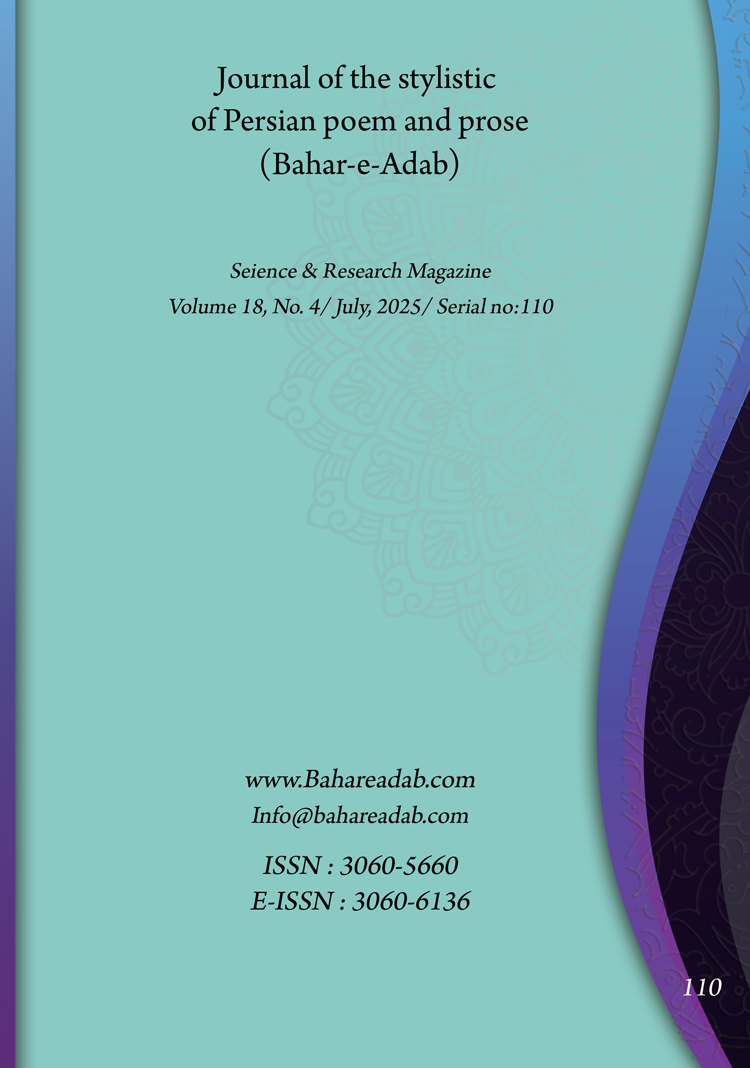- Count View : 83
- آدرس کوتاه شده مقاله: https://bahareadab.com/article_id/1835
- کد doi مقاله: Doi: 10.22034/bahareadab.2025 .18 .7833
Journal of the stylistic of Persian poem and prose
volume Number 18،
number In Volume 4،
،
issue Number 110
Perspective and Origin of Speech in Mystical Lyric Poetry with a Comparative Comparison of the Lyric Poetry of Rumi and Bidel Dehlavi
Mohammad Mir (Author in Charge)
Abstract
BACKGROUND AND OBJECTIVES: Perspective is the perspective, perspective, and situation from which the story is seen and narrated, the mind, and the eye of the poet or writer, and the origin of speech also represents the thought of the anthropologist and the inner world of man composed of thought and value. Mystical literature has reached the pinnacle of meaning with the unique works of Rumi and Bidel Dehlavi.
METHODOLOGY: Since there are fundamental differences in the way of narration and the choice of point of view to express mental hiddenness and mystical-intuitive experiences and perceptions in mystical ghazals, this research seeks to answer this question: What is the point of view and origin of speech in the ghazals of Angha Qaf-e-Marefat Rumi and the ghazals of Bidel Dehlavi? Study method: The research method in this study is analytical-descriptive, and its data was collected based on documentary and library methods.
FINDINGS: The findings of this study show that the point of view in mystical ghazals is a tool for expressing the epistemological developments and spiritual behavior of the poet. In Rumi"s ghazals, the first-person point of view presents an inner and intuitive experience of love and death, while the third-person point of view reveals different dimensions of mysticism. Bidel also emphasizes the mirage-like and unstable nature of truth in these two points of view.
CONCLUSION: The result indicates that the perspective resulting from the origin of speech is a tool for expressing the cognitive developments and spiritual behavior of the poet. Rumi, with a dynamic and behavioral perspective, saw the truth in passing through cognitive stages, but Bidel, with a skeptical perspective, saw knowledge as impossible in some cases and finding the truth as difficult and always ambiguous. Therefore, this fundamental difference in the views of these two poets has made the choice and type of perspective in their lyric poems a determining factor in understanding their poems.
Keyword
perspective
, origin of speech
, mystical lyric poems
, Rumi
, Bidel Dehlavi
- Bazi, A., et al. (2022). A Comparative Study of the Content of Mystical Ghazals by Attar and Rumi with the Mystical Ghazals of Saadi and Hafez. Journal of Islamic Mysticism (Religions and Mysticism), Vol. 18, No. 71, pp. 231-250.
- Dad, S. (1992). Dictionary of Literary Terms, First Edition. Tehran, Morvarid Publications.
- Gabura, C. (2022). Virtualities of lyricization of the heterodiegetic narrative regime. Intertext. https://consensus.app/papers/virtualities-of-lyricization-of-the-heterodiegetic-gabura/895dea01392d547084745b1eaba21e68/?utm_source=chatgpt
- Hühn, P. (2010). Plotting the lyric: Forms of narration in poetry. Literator: Journal of literary criticism, comparative linguistics and literary studies, 31(3), 17-48.
- Mir Sadeghi, J. (1987). Narrative Literature, Second Edition. Tehran, Mahoor Publishing.
- Mohammadi, M.H. (2002). Point of View in Poetry. Journal of the Faculty of Literature and Humanities (Tehran), Vol. 4, No. 8-7-6 (Supplement), pp. 127-136.
- Ranjbar, M. A. (2021). Investigating the Element of Narrator or Point of View (Iltifat Technique) in Hafez's Poetry. The Seventh National Conference on New Research in the Field of Persian Language and Literature.
- Rashidi, S; Yahyaei, M. (2013). Investigating the Perspective and Types of Narrators in Children's Stories. Journal of Persian Prose Research, Year 15, No. 30, Spring and Summer, pp. 133-151.
- Rostami, M; Mahmoudi, A. M. (2024). A Comparative Study of Narrative Elements in Past and Contemporary Persian Narrative Ghazal. Journal of Literary Techniques, Year 17, No. 1 (Serial No. 50), Spring, pp. 46-27.
- Snarey, N. (2017). Lyric poetry and the positioning of the lyric speaker. Unpublished dissertation.
- Tajerian, A; Sotoodeh, G. (2011). The Narrator and Audience in Rumi's Ghazals. Journal of Stylistics of Persian Poetry and Prose (Bahar-e Adab), Year 4, No. 4, Winter, Serial No. 14, pp. 1-14.

